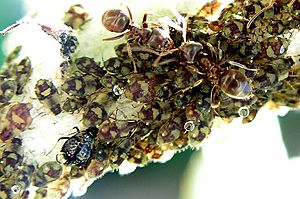Honeydew facts for kids
Honeydew is a sweet, sticky liquid. It's made by tiny insects like aphids and some scale insects. These insects make honeydew when they feed on the sap inside plants. It's often found as a shiny, sticky layer on leaves and stems.
Contents
How Insects Make Honeydew
Honeydew is created when aphids or scale insects eat plant sap. Plant sap is like the plant's blood, full of water and sugars. These insects have special mouthparts that are like tiny straws. They push these straws into the plant to reach the sap.
The Process of Sap Eating
Inside the plant, the sap is under pressure. This pressure pushes the sap into the insect's body. The insects drink a lot of sap to get enough nutrients. Sometimes, they take in more liquid than they need. When this happens, the extra liquid, which is mostly sugar water, is pushed out from the insect's rear end. This sweet liquid is honeydew.
Where Honeydew Goes
Once it leaves the insect, honeydew often drops onto the leaves and stems below. This creates a sticky, shiny coating on the plant. If you've ever walked under a tree and felt a sticky drizzle, it might have been honeydew!
What Happens to Honeydew?
Honeydew can cause some problems for plants. It can also be a valuable food source for other creatures.
Sooty Mould on Plants
When honeydew stays on plants, it can lead to a problem called sooty mould. Sooty mould is a type of fungus that grows on the sugary honeydew. It looks like a black, powdery layer on the plant's leaves. This mould can block sunlight from reaching the leaves, which makes it harder for the plant to make its own food.
Honeydew as Food
Many other insects love honeydew because it's full of sugar. Some wasps and honey bees collect it. Certain honey bees even turn honeydew into a special kind of honey. This honey is usually darker and has a stronger taste than regular flower honey. In some parts of Europe and Asia, people value this "honeydew honey." They sometimes believe it has special health benefits.
Ants and Aphids: A Sweet Partnership
One of the most interesting relationships involving honeydew is between ants and aphids. Ants really enjoy eating honeydew.
Ants "Farm" Aphids
Many ants will actually "farm" aphids. This means they protect the aphids and collect the honeydew directly from them. The ants gently stroke the aphids with their antennae. This encourages the aphids to release drops of honeydew. The ants then drink the honeydew right away.
Protection for Aphids
In return for the sweet treat, the ants protect the aphids. They chase away predators that want to eat the aphids. For example, ants will fight off lady beetles, which are a common enemy of aphids. This partnership helps both the ants get food and the aphids stay safe.


